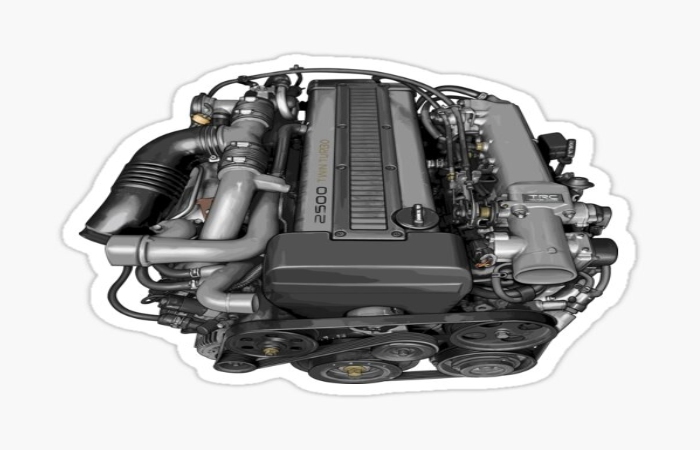Table of Contents
1JZ GTE Engine Description
The Supra MK3 is equipped with a six-cylinder Toyota engine, the 1JZ-GTE. Other Toyota vehicles sold in Japan and overseas, including the Soarer, Corona, and Chaser, also employ the twin-turbo engine.
The device is not offered in any car that Toyota sells in the United States. That has not stopped some owners from importing the machine for the car, given its significant power advantage over Toyota-equipped machines—in the United States market. The 2,491cc engine is a twin-turbocharged straight-six design. Its dual-shaft, belt-driven overhead valve train features four valves per cylinder. Use of high-quality, 91 octanes or higher fuel is required. The compression ratio was reported at 8.5.

Modifications
There were several generations of 1JZ-GTE engines. In the original version, the ceramic turbine discs were imperfect and prone to delamination at high speeds and operating temperatures. The defect of the first generation is a malfunction of the one-way valve, which leads to the diffusion of crankcase gases into the intake assorted, resulting in a reduction in engine power.
The updated engine was equipped with the then-innovative VVT-i system with updated valve seals to reduce camshaft friction, substantially variable valve timing, and the ability to cool the cylinders effectively. These developments have better the physical firmness ratio of the engine and reduced fuel consumption.
Also Read: Xerox Machine Write for Us, Contribute, and Guest Post
Service Regulation
Change the engine oil every 5-10 thousand kilometres. Pour 4.5-5.4 litres of oil depending on the car’s driving. It suggests deciding in advance which oil to pour. Lubricant specifications must be within 0W-30 / 10W-30;
Replace the timing belt at least every 100 thousand kilometres;
Valve adjustments must be yourself carry out once every 100 thousand km, using front washers.
- belt tension;
- ignition timing;
- cylinder head condition;
- status of the turbocharging system;
- EFI fuel injection system
- electric equipment.
1JZ GTE Overview
More about the problems and their solutions:
- If Dzhizetov’s “six” does not start, you must first check the candles. They can fill, and then you need to unscrew the elements and dry them. In general, this turbo version is afraid of cold and moisture; therefore, laundry completes carefully;
- If the engine is troit, the main reason for the restyled version is associated with the ignition coils. Also, on machines with a new Toyota gas distribution system, reason be hidden in the valve;
- Check valve timing, XX sensor, or throttle if the speed is floating. In most cases, the motor runs like clockwork again after flushing clogged items;
- If the engine consumes a lot of fuel, the cause initiates in the oxygen sensor. It recommends to check the quality of the filters;
- If the internal combustion engine knocks, this is most often due to the failure of the clutch of the gas distribution system. Unfortunately, your resource is small. Valves that require manual adjustment can also knock. Excessive noise created by worn connecting rod bearings, as well as a troublesome belt tensioner bearing;
- If there is large oil consumption, this is due to mileage. This problem is standard on the 1JZ GTE due to wear on the valve stem seals and rings. However, it would be correct not to do major repairs on huge runs and replace them with a contract.
List of car models in which the 1JZ GTE install
- Toyota Supra MK III;
- Toyota Mark II Blit;
- Toyota en Verossa;
- Toyota Chaser/Cresta/Mark II Tourer V;
- Toyota Corona (JZS170);
- Toyota in Vero
According to car owners, with an agile method and high-quality tuning, the Toyota 1JZ-GTE engine can run up to 500-600 thousand km, which once again confirms its reliability.
Also Read: Bandwidth Cap Write for Us, Guest Post, and Contribute
Cons
Even these famous and legendary engines have their drawbacks. Among the mechanics we distinguish:
- Lack of hydraulic lifters. Both engines have washer-regulated valves. Adjustment is necessary once every 80-100 thousand kilometres. Not that the lack of a “affects power, but it does make maintenance a bit more time-consuming. For “athletes”, this, of course, is not a problem, but for the stock engine – at least a small one, but harmful.
- Weak timing belt tensioner. The belt resource declared by the plant at the level of 100 thousand kilometres is not insufficient, but due to the tensioner, it may break earlier. Fortunately, all engines, except versions with direct injection, are “non-pluggable”; when the belt breaks, pistons and valves do not start. But all the same, this is unpleasant when there are problems with the timing belt due to the tensioner.
- Resource By engine standards is tiny. The water pump runs 150-200 thousand kilometres. For other cars, it is perfect, but for “jazytes”, it is usually the first to fail.
- Unreliable. The situation is almost the same as with the pump; this element is less reliable than everything else. Due to the pump and viscous coupling, motors can overheat, especially during heavy loads.
- Poor cooling of the sixth cylinder. The problem is more related to the atmospheric version of 1JZ, especially before the improvements. The engineers did not calculate the lines for heat removal, and the last cylinder in the constant load mode overheated. In other versions, the problem is much less pronounced.
Conclusion
The final version of the 1JZ engine also changed from the original twin-turbo charger setup to a more extensive single-turbo design. This engine could create at the high end of Toyota’s nineties car lineup, including the Soarer, Supra and “Tourer V” alternates of the JZX family.
Related posts
Featured Posts
What is High-speed Internet?
High-Speed Internet High-velocity Internet, also referred to as broadband Internet, is defined via the Federal Communications Commission (FCC) as Internet…
What is Bitcoins-Era?
Bitcoins-Era is a trading podium that uses a sophisticated artificial intelligence system capable of analyzing the market and autonomously buying…


